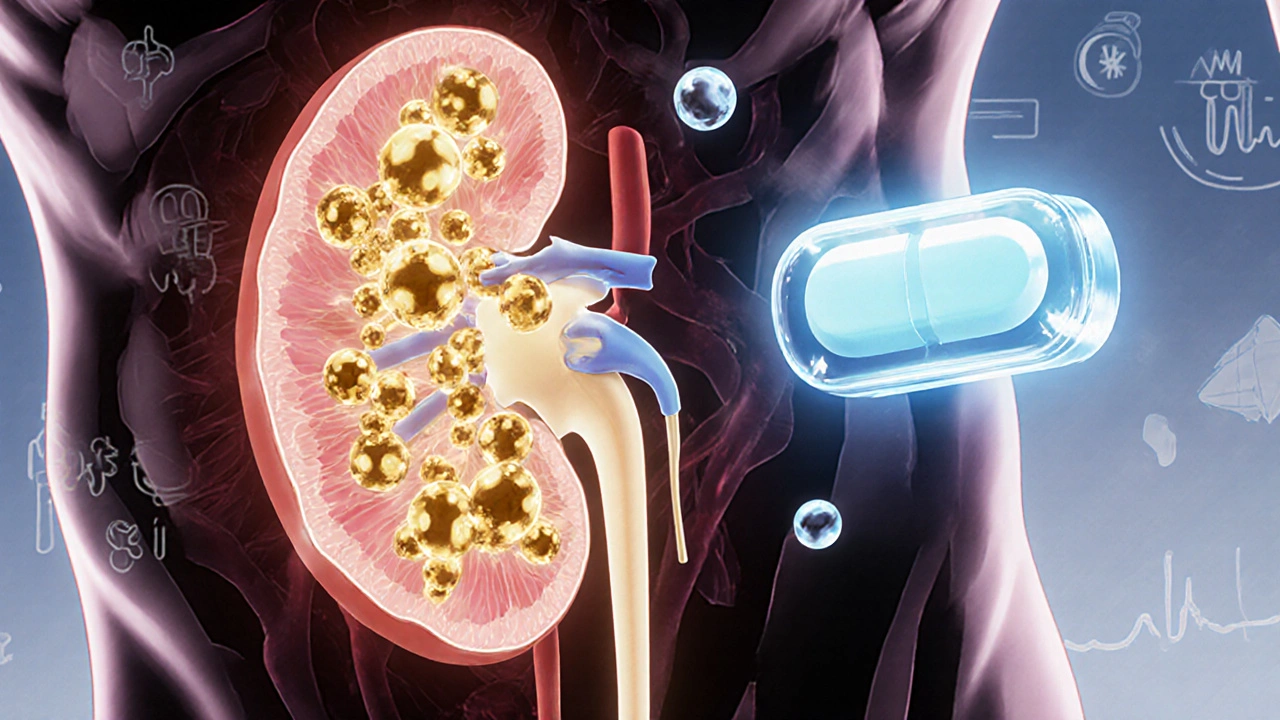How Eplerenone Helps Lower High Blood Pressure

High blood pressure doesn’t always respond to the usual suspects-diuretics, ACE inhibitors, or beta-blockers. For some people, the problem isn’t just salt or stress. It’s a hormone called aldosterone running wild. That’s where eplerenone comes in. Unlike other blood pressure meds, eplerenone doesn’t just push fluid out of your body. It targets the root cause: too much aldosterone binding to receptors in your kidneys and blood vessels, causing sodium retention, potassium loss, and stiff arteries.
What Exactly Is Eplerenone?
Eplerenone is a mineralocorticoid receptor antagonist. That’s a fancy way of saying it blocks aldosterone, a hormone made by your adrenal glands. Aldosterone tells your kidneys to hold onto sodium and water, which increases blood volume-and pressure. In people with resistant hypertension or heart failure after a heart attack, aldosterone levels can stay high even when other treatments are working.
First approved by the FDA in 2002, eplerenone was developed as a safer alternative to spironolactone, an older drug in the same class. Spironolactone can cause side effects like breast tenderness or sexual dysfunction because it also interferes with sex hormones. Eplerenone is more selective. It sticks to aldosterone receptors without messing with testosterone or estrogen. That makes it a better long-term option for many patients.
Who Benefits Most from Eplerenone?
Eplerenone isn’t for everyone with high blood pressure. It’s most often prescribed when:
- Your blood pressure stays above 140/90 despite taking three or more other medications (resistant hypertension)
- You have heart failure after a heart attack and your ejection fraction is low
- Your blood tests show high aldosterone levels or low potassium despite normal kidney function
- You can’t tolerate ACE inhibitors or ARBs due to cough or swelling
Studies like the EPHESUS trial showed that adding eplerenone to standard heart failure treatment reduced death risk by 15% over 16 months. In hypertensive patients, it typically lowers systolic pressure by 8-12 mmHg and diastolic by 4-7 mmHg-similar to a low-dose thiazide diuretic, but with a different mechanism.
How Does It Compare to Other Blood Pressure Drugs?
Here’s how eplerenone stacks up against common alternatives:
| Medication | Class | Typical BP Reduction | Key Side Effects | Best For |
|---|---|---|---|---|
| Eplerenone | Mineralocorticoid receptor antagonist | 8-12 / 4-7 mmHg | High potassium, dizziness | Resistant HTN, post-heart attack |
| Spironolactone | Mineralocorticoid receptor antagonist | 10-15 / 5-8 mmHg | Breast enlargement, low libido, menstrual changes | Severe resistant HTN (if side effects tolerated) |
| Hydrochlorothiazide | Thiazide diuretic | 8-10 / 4-6 mmHg | Low potassium, gout, increased cholesterol | First-line for most patients |
| Losartan | ARB | 8-10 / 5-7 mmHg | Dizziness, high potassium (less than eplerenone) | Diabetics, kidney protection |
| Amlodipine | Calcium channel blocker | 10-12 / 6-8 mmHg | Ankle swelling, flushing, headache | Older adults, African descent |
Unlike diuretics, eplerenone doesn’t make you pee constantly. Unlike calcium channel blockers, it doesn’t cause swelling in the ankles. But it does carry a risk of high potassium-especially if you have kidney disease or take NSAIDs like ibuprofen. That’s why doctors check your potassium levels before starting and again after two weeks.

How Do You Take Eplerenone?
Eplerenone comes as a 25 mg or 50 mg tablet. Most people start with 25 mg once daily. If your blood pressure doesn’t drop enough after 4-6 weeks, your doctor might increase it to 50 mg. It can be taken with or without food. Unlike some blood pressure pills, it doesn’t need to be taken at a specific time of day.
It takes about 2-4 weeks to reach its full effect. Don’t stop taking it if you don’t feel an immediate difference. High blood pressure doesn’t come with warning signs, so you won’t feel better-but your arteries and heart are still benefiting.
If you miss a dose, take it as soon as you remember. If it’s almost time for the next one, skip the missed dose. Never double up.
What Are the Risks and Side Effects?
The biggest risk with eplerenone is hyperkalemia-dangerously high potassium. Your kidneys normally flush out extra potassium, but if they’re not working well, or if you’re taking other drugs that raise potassium (like ACE inhibitors, NSAIDs, or potassium supplements), levels can climb fast.
Signs of high potassium include:
- Muscle weakness or cramps
- Irregular heartbeat
- Numbness or tingling in hands or feet
- Feeling unusually tired
If you experience any of these, contact your doctor right away. They’ll likely run a quick blood test. In severe cases, high potassium can cause cardiac arrest.
Other possible side effects include:
- Dizziness (especially when standing up quickly)
- Headache
- Upset stomach
- Increased urination (mild, not like a diuretic)
Unlike spironolactone, eplerenone rarely causes breast enlargement or sexual side effects. That’s why it’s often preferred for men and women who need long-term treatment.
What Should You Avoid While Taking It?
Some things can make eplerenone dangerous:
- NSAIDs like ibuprofen, naproxen, or celecoxib-these reduce kidney function and raise potassium.
- Potassium supplements or salt substitutes that contain potassium chloride (like NoSalt or Nu-Salt).
- Other potassium-sparing diuretics like amiloride or triamterene-combining them increases risk of hyperkalemia.
- Severe kidney disease (eGFR below 30) usually means eplerenone isn’t safe.
Even natural supplements like licorice root can raise blood pressure and interfere with eplerenone. Always tell your doctor about everything you’re taking-even herbal teas or vitamins.

How Long Do You Need to Take It?
For most people, eplerenone is a long-term medication. High blood pressure doesn’t go away just because your numbers improve. Stopping the drug can cause your blood pressure to bounce back-sometimes even higher than before.
In patients who’ve had a heart attack, guidelines from the American Heart Association recommend continuing eplerenone for at least 12 months, and often longer, if tolerated. For resistant hypertension, it’s typically lifelong unless the underlying cause (like a tumor on the adrenal gland) is found and treated.
Regular check-ups are essential. Your doctor will monitor your blood pressure, kidney function, and potassium levels every 1-3 months, especially when starting or adjusting the dose.
What If It Doesn’t Work?
If your blood pressure doesn’t drop enough after 8 weeks on 50 mg of eplerenone, your doctor might:
- Add a low-dose thiazide diuretic (like chlorthalidone)
- Switch to spironolactone (if side effects aren’t a problem)
- Check for secondary causes like sleep apnea, kidney artery narrowing, or adrenal tumors
Some patients respond better to combination therapy. A 2023 study in The Lancet showed that adding eplerenone to an ARB and calcium channel blocker lowered systolic pressure by an extra 10 mmHg compared to the triple combo without it.
Don’t give up if one drug doesn’t work. Finding the right combination often takes time-and patience.
Is Eplerenone Right for You?
Eplerenone isn’t a first-line drug. But for people whose blood pressure won’t budge with standard treatments, it can be life-changing. It’s especially helpful if:
- You’re on multiple medications but still above target
- You have heart damage from high blood pressure
- You can’t take ACE inhibitors or ARBs
- You’re worried about sexual side effects from older drugs
It’s not a magic bullet. But when used correctly-with regular monitoring and smart lifestyle choices-it gives you a powerful tool to protect your heart, kidneys, and blood vessels.
Can eplerenone cause weight gain?
No, eplerenone doesn’t cause weight gain. In fact, because it helps your body get rid of excess fluid without depleting potassium, some people notice a slight drop in water weight. Unlike steroids or certain diabetes drugs, it doesn’t increase appetite or fat storage.
Is eplerenone safe for people with kidney disease?
It depends on how severe the kidney disease is. Eplerenone is usually avoided if your eGFR is below 30 mL/min because your kidneys can’t clear potassium properly. For mild to moderate kidney disease (eGFR 30-59), doctors may still prescribe it but with closer monitoring of potassium levels. Always get your kidney function tested before starting.
Can I drink alcohol while taking eplerenone?
Moderate alcohol is usually okay, but heavy drinking can raise your blood pressure and increase the risk of dizziness or fainting. Alcohol also affects kidney function and can interfere with potassium balance. Stick to no more than one drink per day, and avoid binge drinking.
Does eplerenone affect blood sugar?
No, eplerenone doesn’t raise or lower blood sugar. It’s considered safe for people with diabetes. In fact, some studies suggest it may help protect the kidneys in diabetic patients by reducing protein leakage into the urine. Always monitor your glucose levels as usual, but no special changes are needed.
How long does it take for eplerenone to start working?
You won’t feel it right away. Blood pressure usually starts to drop within 1-2 weeks, but it takes 3-4 weeks to reach full effect. Don’t stop taking it if your numbers haven’t changed after a week. Consistency matters more than immediate results.
If you’ve been told your blood pressure is stubborn, don’t assume there’s nothing left to try. Eplerenone offers a targeted, science-backed option for people who’ve hit a wall with standard treatments. With proper monitoring, it can be the missing piece in your heart health plan.

Bobby Marshall
October 31, 2025 AT 19:28Man, I’ve been on eplerenone for a year now after my heart attack, and honestly? It’s the only med that didn’t make me feel like a zombie. No ankle swelling, no constant bathroom runs, and my potassium? Stable. Docs said I was a candidate for spironolactone, but I’ve seen too many guys get gyno from it-no thanks. This thing just quietly does its job. I still eat my bananas, watch my NSAIDs, and check in every 6 weeks. Small price to pay for not feeling like I’m one step from a heart attack every morning.
Subham Das
October 31, 2025 AT 22:39How tragic it is that modern medicine has reduced the human body to a series of hormonal receptor interactions, as if the soul were irrelevant. Aldosterone is not merely a hormone-it is a manifestation of systemic imbalance, a whisper from the body screaming for harmony. Eplerenone, in its clinical precision, silences the symptom while ignoring the root: the modern diet of processed sodium, the sedentary despair of urban life, the spiritual disconnection from natural rhythms. We pharmacologically tame the symptom while the culture continues to poison the well. Is this healing-or merely a more elegant form of denial? The body remembers what the lab report forgets.
Cori Azbill
November 1, 2025 AT 23:49Okay but why is this even FDA-approved? 🤔 I mean, I live in the U.S. and we’re literally drowning in pills. This just sounds like Big Pharma’s way of selling a ‘premium’ version of spironolactone to rich folks who don’t wanna deal with boob issues. Also, potassium? Are you kidding me? I’ve got my aunt who took this and ended up in the ER because she ate a whole bag of salt-free chips thinking ‘oh it’s healthy.’ 😑 We need less magic bullets and more… I dunno… exercise? Or maybe just stop eating fast food? 🇺🇸
Aneesh M Joseph
November 3, 2025 AT 20:55Bro this is just spironolactone with a new label. Same thing. Same side effects. Just cost more. Doc pushes it because it’s ‘nicer’ but if you’re broke, you get the old one. And yeah, potassium’s a thing. But so is being lazy and not checking your numbers. Stop blaming the drug, blame the person who didn’t read the damn pamphlet.
Deon Mangan
November 4, 2025 AT 21:39Let me be the first to say: eplerenone is not a ‘magic bullet’-it’s a precision scalpel. And yes, it’s expensive. But when your ejection fraction is 30% and you’re on 4 other meds, and your BP still hovers at 155/95… you don’t get to be picky. You take the scalpel. You monitor potassium. You avoid ibuprofen like it’s a cursed artifact. And you stop calling it ‘just another pill.’ This isn’t marketing. This is survival. And if your doctor didn’t explain the ‘why’ behind it… that’s on them. Not the drug. 🧪
Ardith Franklin
November 6, 2025 AT 12:12Wait-so this drug is only for people who ‘can’t tolerate ACE inhibitors’? But what if your doctor just doesn’t want to do the work to find out why your BP is stubborn? What if it’s sleep apnea? Or adrenal tumor? Or glyphosate poisoning from your water? They just slap on eplerenone and call it a day. No imaging. No labs. Just ‘try this.’ And now we’ve got a whole generation on meds that mask the real problem. It’s not medicine. It’s corporate triage.
Paul Orozco
November 8, 2025 AT 01:48While I appreciate the clinical detail provided in this exposition, I must express my profound concern regarding the normalization of pharmacological intervention as a first-line solution to what are, in many cases, lifestyle-induced conditions. The absence of any meaningful discussion regarding dietary sodium reduction, aerobic exercise, or stress mitigation protocols is not merely an oversight-it is a systemic failure of medical education. Furthermore, the casual recommendation of long-term use without addressing root behavioral etiologies borders on medical malpractice disguised as innovation.
Jenny Kohinski
November 9, 2025 AT 00:08Thank you for writing this. I’m a diabetic and was terrified this would mess with my sugar, but now I feel way better about trying it. My dad had a heart attack last year and they put him on this-he’s been stable for 18 months now. I just wish more people knew how gentle it is compared to other meds. 💛 Also, if you’re on this, please don’t skip your potassium checks. I know it’s annoying, but it’s the thing that keeps you alive. You got this.